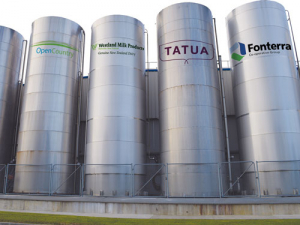Fonterra slashes forecast milk price, again
Fonterra has slashed another 50c off its milk price forecast as global milk flows shows no sign of easing.
 The report says Fonterra’s competitors have grown their milk volumes by an average of 10% over the last 5 years.
The report says Fonterra’s competitors have grown their milk volumes by an average of 10% over the last 5 years.
The revenue range/kgMS of New Zealand’s dairy companies is remarkably wide – from Tatua’s $18.58 to Fonterra’s commodity return of $5.81 – says a new report on the dairy industry.
‘New Zealand Dairy Companies Review’, published in April by TDB Advisory (TDB), reviews the performance of Fonterra’s milk processing competitors in NZ, the four that make their financial reports public – OCD, Synlait, Tatua and Westland. Each is a major company in its own right.
The revenue range reflects the differing strategies of the various companies, TDB says.
Among Fonterra’s competitors Tatua is recognised as having a strong focus on high-value ingredient products while Open Country Dairy (OCD) has a strong focus on commodity products, TDB says. In between are Synlait, with its specialty ingredient business-to-business strategy, and Westland which produces both commodity products and consumer products.
Tatua has invested more than any of the other companies to generate higher sales per kgMS, while OCD has invested the least, TDB says. However, revenue generated per kgMS is only part of the consideration and doesn’t reconcile with profitability.
TDB’s figures show OCD as the lowest-cost operator at $2.35/kgMS while Tatua is the highest at $11.26. Synlait’s operating costs are $4.51/kgMS and Westland’s $5.57.
The report says the industry and various commentators have for many years referred to the possibility of growing the value-added component of milk sales, but that might be difficult.
“Fonterra processes over 1.5 billion kgMS in NZ and if the co-op was to manufacture a similar product mix to Tatua, even if it could, it would require an extra investment of over $7b in fixed assets (to at least double its current investment in NZ plant and equipment).
“This would equate to an additional investment of about $675,000 per farmer-shareholder, with no guarantee of success. Operating costs will be lower for the commodity processors but there is not enough public information for us to make direct comparisons,” the report says.
While Fonterra remains the dominant processor in NZ, its share of ‘new’ milk is estimated to be two thirds, the report says.
“Their respective amounts of new committed processing investment and access to capital indicate the competing companies are likely to continue to grow faster than Fonterra.” Fonterra’s market share could fall from 84% to 79% over the next five years.
TDB estimates the combined value of the assets of Fonterra’s competitors is at least $2b and their revenue exceeds $2.5b.
With combined annual sales of about $2.3b (for 2016), the four companies collectively account for 90% (by milk volume) of the milk processed by Fonterra’s competitors in NZ.
The report says Fonterra’s competitors have grown their milk volumes by about 10% on average over the last five years: OCD has growth of 10%, Synlait 7%, Westland 6%, Tatua 4%, Miraka an estimated 10% and Oceania an estimated 15%.
Other growth points to note include:
• Synlait’s September 2016 capital raising and news of a $300m capital expansion project over three years
• OCD’s recent news that it is preparing to build a new powder plant at Horotiu, Waikato, for the start of the 2018-19 dairy season. It will have capacity for 250m L of milk, an increase of 20% on 2016 volumes
• Oceania’s intention to triple in size to 630m L by 2019. The report notes that its catchment area includes the Hunter Downs irrigation scheme, whose construction is expected to markedly increase milk volumes on farms
• Westland’s current performance review indicating a lower cost structure.
The report says if the annualised industry growth in milk volumes over the next five years is (as Fonterra and DairyNZ expects) in the 2-3% range and Fonterra’s competitors maintain their 10% growth rate, their market share will increase from the current 16% to 21%.
Oceania, Yashili and Miraka were not covered in detail in the report.
It did not include Miraka because its financial statements are not public.
Mating wrapped up last month at the across-breed Beef Progeny Test on Pāmu’s Kepler Farm in Manapouri.
Libby Judson is a keeper of memories from an age gone by. Tim Fulton tells her story.
A New Zealand-first native tree study has highlighted the Bioeconomy Science Institute's position as a forestry research leader.
Hemp fibre processor Rubisco is relocating its core processing facility to Ashburton as part of a $20-$30 million expansion to leverage what it says is an accelerating global demand for sustainable and renewable fibres.
Tradition meets some of the latest in technology at the 2026 East Coast Farming Expo.
OPINION: Trade Minister Todd McClay and the trade negotiator in government have presented Kiwis with an amazing gift for 2026 - a long awaited and critical free trade deal with India.

OPINION: If the hand-wringing, cravat and bow-tie wearing commentariat of a left-leaning persuasion had any influence on global markets, we'd…
OPINION: With Winston Peters playing politics with the PM's Indian FTA, all eyes will be on Labour who have the…